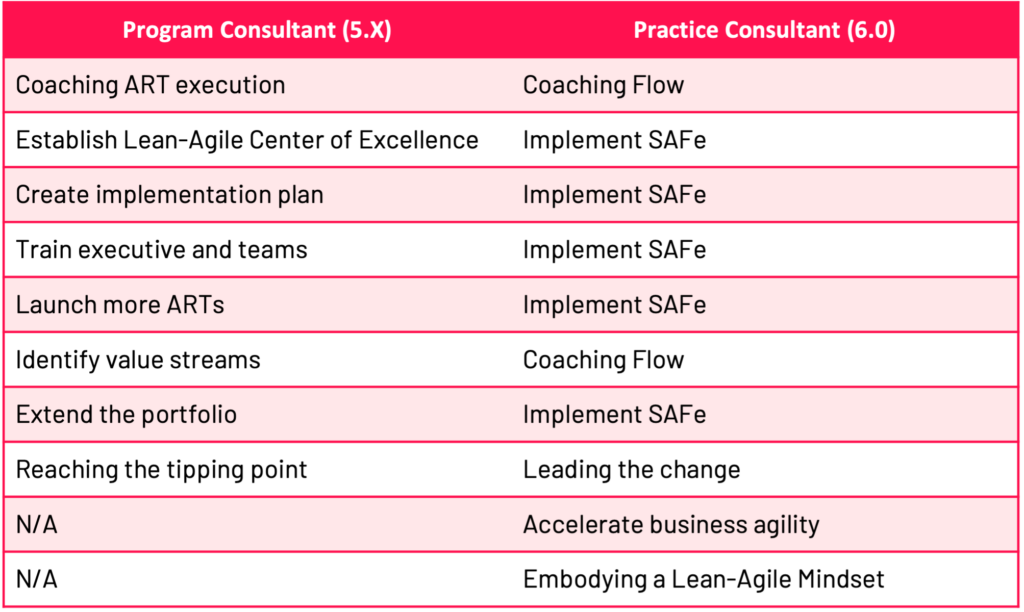SAFe® 6.0 Deep Dive – The New SAFe Practice (NOT Program) Consultant
Upon its release early in 2023, SAFe® 6.0 brought about several changes to the framework, one of which may be the most important and impactful to you if you are a current SPC (SAFe Program Consultant).
The role of the SPC is key to any SAFe adoption because SPCs provide the foundation on which we build the change initiative. Because we need SPCs to provide the training, coaching, and mentoring that most organizations lack, having a keen understanding of the new SPC (SAFe Practice Consultant) is essential.
So what has changed other than the title? Let’s take a closer look.
What’s changed about the SPC role?
While the core responsibilities of the SPC remain largely the same, many subtle changes add up to a meaningful revision that is worth noting and studying, especially if you already have SPCs supporting your Agile Release Train (ART). While some changes may seem minor, others may alter how you perceive and leverage your SPC skill set.
In the following table, I have summarized the primary responsibilities of the SPC for both version 5.X and 6.0. You may notice that several items have either been merged or enhanced. Next, we’ll dive deeper into the importance of these changes.
Key Differences
Why were the changes made?
No, Scaled Agile Inc. isn’t just trying to keep you on your toes, or necessitate new business cards. These changes—some subtle, some not so much—were made for a few important reasons.
Emphasis on business agility, not just engineering or product development
Previous versions of SAFe emphasized Lean-Agile systems development, which focused primarily on defining, building, testing, and deploying of technology-centric products and services.
While this theme has been important, and will continue to be valuable for most business organizations, SAFe 6.0 recognizes the need to expand beyond IT functions because large organizations are very complex, encompassing much more than just IT. By placing focus on the overall business as a system, they have widened the realm of possibility for SAFe to other functions, such as Finance, Human Resources, Business Development/Marketing, and more.
This also redefines the Value Stream to expand beyond the boundaries of IT. For organizations that may have begun their SAFe journey within the technology world, this enhancement enables further application of SAFe to other parts of the company.
Focus on values and behavior; modeling over telling/teaching
Scaled Agile Inc. modeled the SAFe Program Consultant after an advisor, trainer, consultant role—someone who provides guidance and advice, and primarily tells an organization what they are doing right or wrong as they attempt to induce change where needed.
The new SPC places more emphasis on a different approach, which is akin to professional coaching. With new terminology such as “coaching” and “embodying”, SAFe 6.0 emphasizes a softer, more people-centric approach to the “consulting” responsibility. This is exemplified in the new prioritization of the Continuous Learning Culture within SAFe 6.0.
Which changes should you care about?

There are several ways to explore the new SPC responsibilities and determine if/when you may wish to adopt them.
One method is to establish a community of practice for SPCs and encourage the members to exchange their ideas on what this change means to them and your organization. By allowing the SPCs to develop their own vision for the future state, they are much more likely to take ownership of this change and follow through on the execution.
To complement this approach, it may also be helpful to build a high-level change roadmap to help structure the application of the new responsibilities defined for the Practice Consultant.
Closing thoughts
The SPC role is the cornerstone to any SAFe-enabled initiative, so taking the time to make sense of these new and changed responsibilities is an important investment, especially if you have already made a commitment to apply SAFe within your company.
As with all changes, adopting the new role does not have to be a onetime project; if you can incrementally apply small changes that make sense for your SPC community, you may realize the benefits faster than expected.
Dive deeper into the new SPC role and how your organization can best adopt the changes to the role by exploring our learning course, Implementing SAFe – Certified SAFe Practice Consultant.
SAFe and Scaled Agile Framework are registered trademarks of Scaled Agile, Inc.




